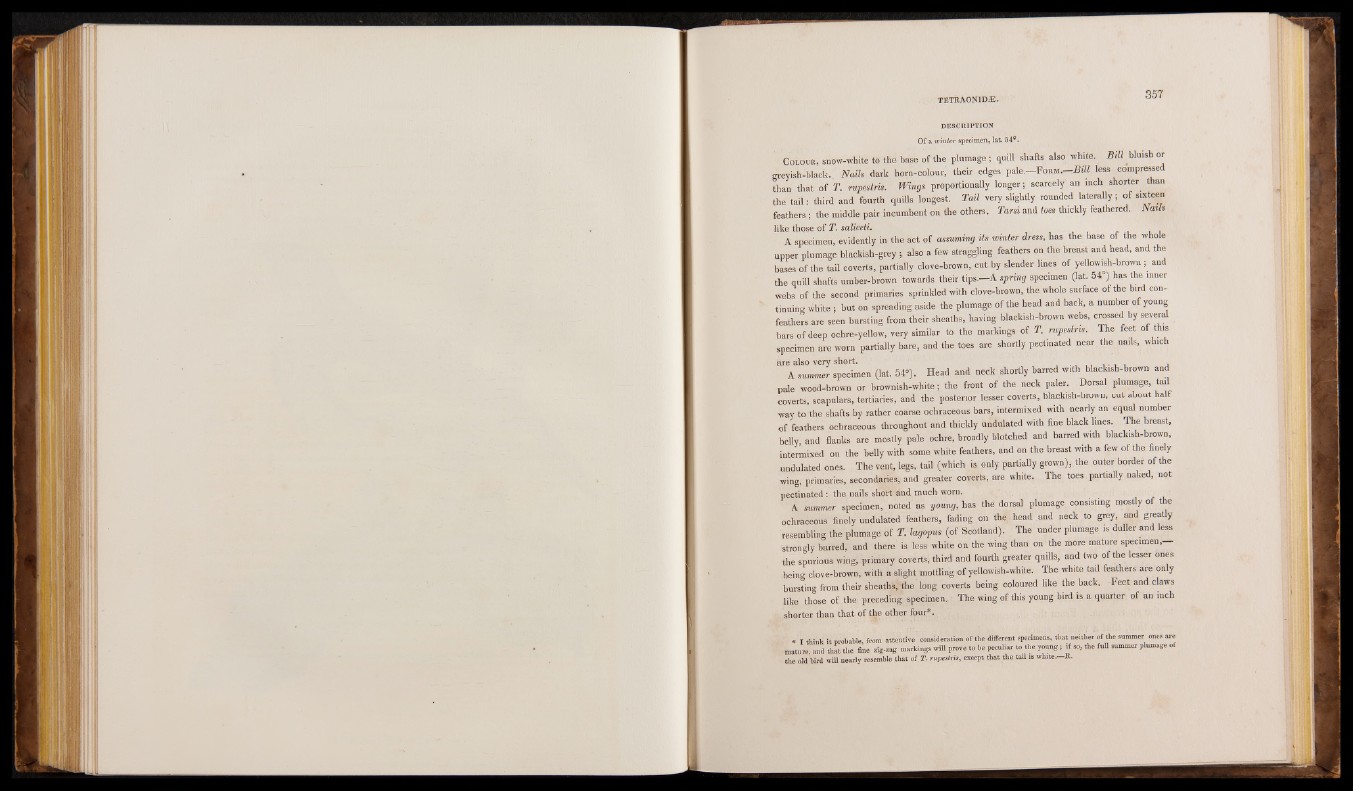
DESCRIPTION
Of a winter specimen, lat. 54°.
C olour, snow-white to the base of the plum age; quill shafts also white. Bill bluish or
greyish-black.. Nails (lark horn-colour,' their edges pale.—F o r m .— Bill less compressed
than th at of T. rupestris. Wings proportionally longer 9 scarcely an inch shorter than
the tail: third and fourth quills longest. Tail very slightly rounded laterally; o f sixteen
feathers ; the middle pair incumbent on the others. Tarsi and toes thickly feathered. Nalls
likAe tshpoescei mofe nT,. esvaildiceenttil.y in the act of assuming its winter dress, has the base of the whole
upper plumage blackish-grey ; also a few straggling feathers on the breast and head, and the
bases of the tail coverts, partially clove-brown, cut by slender lines of yellowish-brown I and
the quill shafts umber-brown towards their tips.—A spring specimen (lat. 54°) has the inner
webs of the second primaries sprinkled with clove-brown, the whole surface of the bird continuing
white ; but on spreading aside the plumage of the head and back, a number of young
feathers are seen bursting from their sheaths, having blackish-brown webs, crossed by several
bars of deep ochre-yellow, very similar to the markings of T. rupestris. The feet of this
specimen are worn partially bare, and the toes are shortly pectinated near , the nails, which
A summer specimen (lat. 54“). Head and neck shortly barred with blackish-brown and
pale wood-brown or brownish-white; the front of the neck paler. Dorsal plumage, tail
coverts, scapulars,.tertiaries, and the posterior lesser coverts, blackish-brown, cut about half
way to the shafts by rather coarse ochraceous bars, intermixed with nearly an equal number
of feathers ochraceous throughout and thickly undulated with fine black lines. The breast,
belly, and flanks are mostly pale ochre, broadly blotched and barred with blackish-brown,
intermixed on the belly with some white feathers, and on the breast with a few of the finely
undulated ones. The vent, legs, tail (which is only partially grown), the outer border of the
wing, primaries, secondaries, and greater coverts, are white. The toes partially naked, not
pectinated: the nails shott and much worn.
A summer specimen,'noted as yowng, has the dorsal plumage consisting mostly of the
ochraceous finely undulated feathers, fading on the| head and neck,to grey, and greatly
resembling the plumage of T. lagopus (of Scotland). The under plumage is duller and less
strongly barred, and there is less white on the wing than on the more mature specimen,
the spurious wing, primary coverts, third and fourth greater quills, and two of the lesser ones
being clove-brown, with a slight mottling of yellowish-white. The white tail feathers are only
bursting from their sheaths, the long coverts being coloured like the back. Feet and claws
like those of the preceding specimen. The wing of this young bird is a quarter, of an inch
shorter than that of the other four*.
» I think it probable, from attehtii-e consideration of the different specimens, that neither of the summer ones are
mature, and that the fine sig-sag markings will prove to be peculiar to the young I g so, the full summer plumage of
the old bird will nearly resemble that of T. rupestris, except that the tail is white.—R.